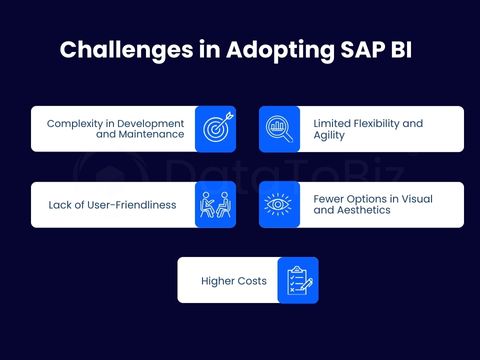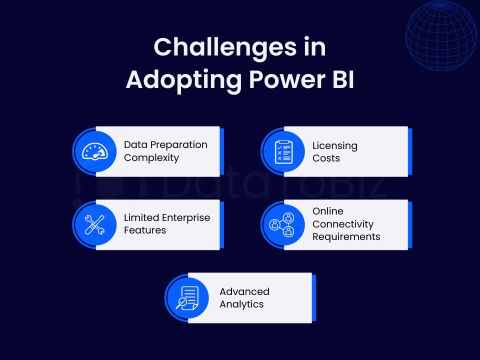Whether you’re a decision-maker in the business world seeking clarity or simply interested in the business intelligence landscape, this summary offers insights into the crucial distinctions between Power BI vs SAP BI. Use this information to make a well-informed choice when selecting the ideal BI solution for your enterprise.
Power BI and SAP BI are two prominent players in the competitive space of business intelligence solutions. According to the reports, Microsoft Power BI has a market share of 14.31% in the global business intelligence (BI) market, while SAP Business Objects has a market share of 5.51%, each offering unique features and capabilities to help organizations derive meaningful insights from their data.
Power BI, developed by Microsoft, is a user-friendly and highly accessible tool known for its intuitive interface and integration with other Microsoft products. It empowers users to easily create interactive reports and dashboards, making it a preferred choice for small to mid-sized businesses and individuals looking for a self-service BI solution.
On the other hand, SAP BI, part of the SAP BusinessObjects suite, is lauded for its robustness and scalability. It’s a trusted choice for larger enterprises that require complex data modeling, extensive data governance, and high-level security. Both solutions have pros and cons, and the choice between Power BI and SAP BI ultimately depends on your organization’s specific needs, size, and IT infrastructure. In the upcoming sections, we’ll delve deeper into these differences to help you decide when selecting the best business intelligence solution for your enterprise.
For SAP BI users, navigating the world of business intelligence comes with its own set of challenges and It’s essential for organizations to assess if the advantages of SAP BI are worth the complexities it brings before deciding to adopt this powerful business intelligence solution. These hurdles include:

While Power BI offers numerous advantages, understanding these challenges helps organizations make informed decisions regarding the adoption of Power BI, ensuring it aligns with their specific business needs and constraints.

Power BI offers robust data integration capabilities and supports a wide range of data sources, including SAP systems. It provides seamless integration options, allowing users to connect to various databases, cloud services, on-premises data, and more. Power BI also offers Power Query, which enables users to transform and shape data from different sources.
SAP BI, being part of the SAP ecosystem, naturally integrates well with SAP data sources and systems. It is optimized for accessing data from SAP applications and SAP HANA. However, its connectivity to non-SAP data sources may require additional configurations and connectors.
Power BI is known for its rich set of interactive visualizations and customizable dashboards. Users can create visually appealing reports using various chart types, graphs, maps, and custom visuals. Power BI also has a vast library of community-created visualizations available through its marketplace.
SAP BI offers a range of visualizations, but it may not be as extensive or as user-friendly as Power BI in terms of customization and interactivity. It is more focused on traditional enterprise reporting and analytical templates.
Power BI empowers business users with self-service analytics capabilities. Users can create their own reports, dashboards, and analyses without heavy reliance on IT or data experts. The intuitive interface and natural language query feature make it accessible to a wide range of users.
While SAP BI has self-service analytics features, it may require a steeper learning curve compared to Power BI. It often involves more complex data modeling and may be better suited for users with some technical background or training.
Power BI supports building a scalable ecosystem that allows for enterprise-wide adoption. It offers cloud-based and on-premises deployment options to meet the needs of organizations of all sizes. The Power BI service enables collaboration, sharing, and distribution of reports and dashboards within the organization.
SAP BI is designed for scalability and can handle the demands of large enterprises. It seamlessly integrates with other SAP solutions and can be part of a comprehensive SAP landscape. However, it may involve higher initial implementation costs and more complex configurations, which could make it better suited for large organizations.
While both Power BI and SAP BI have their merits, Power BI provides distinct advantages in terms of user productivity, adaptability, collaboration, and cost-effectiveness. These advantages make Power BI an appealing choice for organizations, especially smaller to mid-sized ones, looking to maximize their business intelligence capabilities while keeping costs in check. However, the choice between the two still depends on specific business needs, existing IT infrastructure, and user expertise, as well as the scale and complexity of the organization’s data and reporting requirements.
When evaluating BI tools for an enterprise, it’s essential to consider various factors like the existing architecture, user expectations, data sources, fulfillment of requirements, and training complexity. Both SAP Analytics Cloud and Power BI have their strengths and are best suited for specific scenarios.
But considering the discussed factors, it’s quite clear that Power BI is the top choice for existing Azure and MS SQL customers, as well as situations involving numerous data sources other than SAP. It’s also the preferred option when an organization primarily relies on non-SAP sources, values visually appealing presentations, permits data replication, and needs data transformation using DAX expressions. On the other hand, SAP Analytics Cloud is the ideal pick when your reports are primarily based on SAP data sources, necessitate real-time data, and require authorization and role structures to be set up at the source.
Hence, the choice between Power BI and SAP Analytics Cloud hinges on the unique characteristics and requirements of your organization, ensuring that you can leverage the right tool to maximize your business intelligence capabilities.
